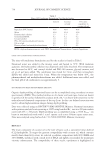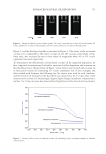699 UV OXIDATION resulting solutions were shaken for 1 h, sonicated for 1 h, and then shaken for an additional 1 h to ensure partitioning of the hydrophobic metal salt into the colloidal system. FLUORESCENCE ANALYSIS OF COLLOIDAL SYSTEMS After each sample had been irradiated, 150 μL of ethanol was added to dissolve any aggregates. Then, 200 μL of the resulting solution was withdrawn, and 400 μL of each 0.1 M pH 5 acetate buffer and 0.4 M pH 8.5 borate buffer was added. This decreased the ethanol concentration sufficiently for micelle structures to form, as tested by dynamic light scattering. Fluorescence excitation and emission spectra were recorded, with an average of three scans taken for each sample. (Excitation parameters: emission wavelength, 303 nm excitation scan, 240–300 nm. Emission parameters: excitation wavelength, 276 nm emission scan, 270–500 nm.) Dityrosine fluorescence was also monitored. (Excitation parameters: emission wavelength, 405 nm excitation scan, 240–400 nm. Emission parameters: excitation wavelength, 320 nm emission scan, 325–550 nm.) The extent of tyrosine degradation was measured as a percentage decrease in the tyrosine emission maximum intensity at 310 nm relative to the dark control for each sample. Fluorescence measurements were performed on a Hitachi F-4500 fluorescence spectrophotometer using 1 × 1 cm quartz cells. Samples were treated after irradiation to remove metals before fluorescence measurements were made. Iron was removed from the samples by the precipitation as Fe(OH) 3 at high pH: To 140 μL samples was added 150 μL of dilute NaOH solution (194 mM). Samples were shaken and left for 10 min for precipitation to occur and were then filtered through 450 nm polytetrafluoroethylene filters. BUTYLATED HYDROXYTOLUENE (BHT) EXPERIMENTS For studies with butylated hydroxytoluene (BHT) antioxidant, a stock BHT solution in ethanol at a concentration of 1.5 mM was prepared. Specific volumes of the stock solution were transferred into sample vials to give the desired BHT concentration when diluted by a factor of 100. The ethanol was then removed under a vacuum, and PEG 2000 –Tyr 5 polymer solutions (0.5–5 mg/mL, 0.074–0.735 mM) were prepared in 0.1 M pH 5 acetate buffer and added to dried BHT residue. The resulting solutions were shaken for 1 h, sonicated for 1 h, and then shaken for an additional 1 h to ensure partitioning of the hydrophobic antioxidant into the colloidal system. HAIR Human hair for the testing was purchased from International Hair Importers & Products, Glendale, New York. Natural white hair, a hair type that is very low in melanin content, was used for UV biomarker work. HAIR TREATMENTS For biomarker experiments, natural white hair was treated with solutions containing 5% C sinensis extract. These solutions were applied to wet hair and left to dry without rinsing. The resulting samples were compared to baseline untreated hair and UV-exposed-only
700 JOURNAL OF COSMETIC SCIENCE hair (no C sinensis treatment). Hair was exposed to artificial radiation using the settings described in the next section for a total of 60 h. After 20 and 40 h of irradiation, the hair was washed with a clarifying shampoo, and tea solutions were reapplied. The hair was washed again with clarifying shampoo before extraction. EXPOSURE TO ARTIFICIAL RADIATION Hair samples were exposed to simulated sun exposure with an Atlas Ci3000+ Weather- Ometer® (Atlas, Chicago, Illinois). Both internal and external quartz filters were used to simulate broad-spectrum, outdoor daylight with a specific irradiance of 1.48 W/m2 at 420 nm. During the irradiation process, temperature and relative humidity (RH) were kept constant at 35°C and 80% RH, respectively. This amount of irradiation for a total of 60 h simulates and is approximately equivalent to 40 min/d of summer sunlight exposure for 3 months in Miami, Florida. OXYGEN RADICAL ANTIOXIDANT CAPACITY (ORAC) MEASUREMENTS An OxiSelectTM oxygen radical antioxidant capacity (ORAC) activity assay kit was purchased from Cell Biolabs (San Diego, California). For each measurement, a fluorescent probe solution was freshly prepared by diluting stock solution in the assay diluent. A water-soluble analogue of vitamin E, Trolox™ (6-hydroxy-2,5,7,8-tetramethylchroman- 2-carboxylic acid) (Hoffman-LaRoche, Nutley, New Jersey), was used as the standard material. Antioxidant working standard solutions were freshly prepared by diluting 5 mM Trolox™ stock solution in assay diluent. Serial dilution of extract solutions was performed with assay diluent to ensure that the samples were within the calibration curve range and demonstrated dilution integrity. Aliquots (25 μL) of each antioxidant working standard or sample and 150 μL of fluorescent probe solution were added to the predesignated well in a 96-well clear-bottom black plate. The plate was then allowed to equilibrate by being incubated for 30 min at 37°C. Free-radical initiator solution was freshly prepared at 80 mg/ mL in undiluted phosphate-buffered saline. Reactions were initiated by the addition of 25 μL of free-radical initiator solution into each well. Fluorescence signals were read with a Spectramax M3 multimode microplate reader using SoftmaxPro 7.0 software (Molecular Devices, San Jose, California) at 37°C with an excitation wavelength of 480 nm and an emission wavelength of 520 nm for 60 min in increments of 3 min. The final assay values of the blank control should be less than 10% of the initial values for the assay to be completed. A calibration curve was constructed by plotting the differences in the areas under the fluorescence kinetic decay curves against the Trolox™ antioxidant standard concentrations. The ORAC value of the extract solution was determined by back-calculation using a linear regression of the calibration curve and was expressed in terms of micromoles of Trolox™ equivalents after a correction for the dilution factor was applied. BIOMARKER ANALYSIS Samples (0.5 g) of hair from treated tresses were cut and placed into 50 mL tubes with 5 mL of water added. Tubes with hair and water were mixed on a multitube vortex shaker for 60 min at 2,500 rpm. The water portion was then transferred from the tubes by pipette
Purchased for the exclusive use of nofirst nolast (unknown) From: SCC Media Library & Resource Center (library.scconline.org)






































































































































